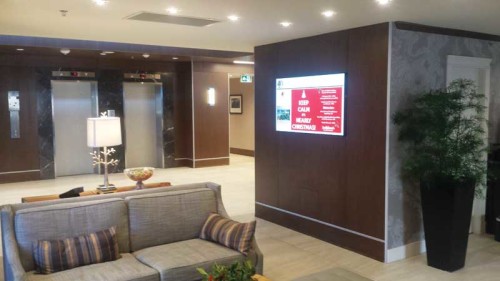3. Quote the job carefully
Everyone wants and needs technology, but few want to pay for it. If the signage provider quotes much over cost for hardware and software, the client may go elsewhere for a cheaper system. It is better to consider all such components—including screens, media players and mounting brackets—as sundry items and mark them up only marginally over cost, then carefully itemize each step required to complete the process. This way, the client is paying for expertise, not for the goods delivered.
Service-related line items with profit margins may include project management, site survey visits, networking co-ordination, installation, training, graphic design, ongoing servicing and surveillance. Noting the ongoing costs upfront, especially, will help avoid any potential animosity later.
If the purpose of the project is digital out-of-home (DOOH) advertising, some clients will want to work out a payment plan that involves matching ad revenue, while others will ‘co-op’ expenses with their vendors. Both scenarios can sometimes work, but the signage provider needs to protect itself. The best approach is to quote all hardware costs upfront and collect payment before shipping.
Some requests for proposals (RFQs) require signage providers to carry the cost of the hardware. This can be a heavy burden if the project goes sideways.

The easiest screen installations are on flat walls, but it is still important to survey the site with a walk-through before quoting the job.
4. Plan the procurement
In today’s age of just-in-time delivery, distributors hold as little hardware as possible in inventory, so it is important to check they have the volume available for the scale required. National digital signage deployments have fallen apart because no one bothered to check first whether the manufacturer had enough stock to roll out.
Most such hardware at a large scale can be expected to take six to eight weeks for delivery. After all, suppliers will need to ramp up manufacturing when a project calls for hundreds or thousands of commercial-grade screens.
For the first install in a large network, the hardware should be shipped directly to the signage provider for in-house ‘staging’ before rolling out to client locations. Thereafter, however, hardware should be shipped directly to the sites, if possible, to reduce the signage provider’s liability. Otherwise, hardware broken in transit without clear lines of responsibility can become expensive.
Also, even when screens, brackets and media players are ordered from a single distributor, they will often arrive from different sources, so it is important for someone on-site to be aware of all the parts and organize them for installation.
5. Book the installation
Installers must have a detailed, clearly defined procedure for dealing with the hardware, including details gleaned from the site surveys and any correspondence with the client. While many traditional signs can be installed during normal work hours, digital signage is particularly popular within retail environments where installation is only possible after hours, with tight job windows. Most challenging are quick-service restaurants (QSRs), where any unforeseen delays can materially affect their business (i.e. if their menus are down).
Also, there usually isn’t enough room for complete staging before actual installation. So, it is imperative for the install team to understand the scope of work in advance. If possible, it is also a good idea to ask for the client’s own IT technician to be on-site for the installation.





